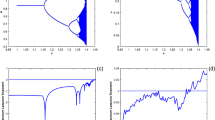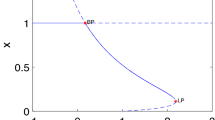Abstract
The equations in the Rosenzweig–MacArthur predator–prey model have been shown to be sensitive to the mathematical form used to model the predator response function even if the forms used have the same basic shape: zero at zero, monotone increasing, concave down, and saturating. Here, we revisit this model to help explain this sensitivity in the case of three response functions of Holling type II form: Monod, Ivlev, and Hyperbolic tangent. We consider both the local and global dynamics and determine the possible bifurcations with respect to variation of the carrying capacity of the prey, a measure of the enrichment of the environment. We give an analytic expression that determines the criticality of the Hopf bifurcation, and prove that although all three forms can give rise to supercritical Hopf bifurcations, only the Trigonometric form can also give rise to subcritical Hopf bifurcation and has a saddle node bifurcation of periodic orbits giving rise to two coexisting limit cycles, providing a counterexample to a conjecture of Kooji and Zegeling. We also revisit the ranking of the functional responses, according to their potential to destabilize the dynamics of the model and show that given data, not only the choice of the functional form, but the choice of the number and/or position of the data points can influence the dynamics predicted.













Similar content being viewed by others
References
Cheng KS (1981) Uniqueness of a limit cycle for a predator–prey system. SIAM J Math Anal 12:541–548
Ermentrout B (2002) Simulating, analyzing, and animating dynamical systems: a guide to XPPAUT for researchers and students. SIAM, Philadelphia
Freedman HI, Wolkowicz GSK (1986) Predator–prey systems with group defence: the paradox of enrichment revisited. Bull Math Biol 48:493–508
Fussmann GF, Blasius B (2005) Community response to enrichment is highly sensitive to model structure. Biol Lett 1:9–12
Gantmacher FR (1959) Matrix Theory, vol I. Chelsea Publishing Company, White River Junction, VT
Harrison GW (1979) Global stability of predator–prey interactions. J Math Biol 8:159–171
Hofbauer J, So WHJ (1990) Multiple limit cycles for predator–prey models. Math Biosci 99:71–75
Holling CS (1959) The components of predation as revealed by a study of small-mammal predation of the European pine sawfly. Can Entomol 91:293–320
Hsu SB (1978) On global stability of a predator–prey system. Math Biosci 39:1–10
Hsu SB, Hubbell SP, Waltman P (1978) Competing predators. SIAM J Appl Math 35(4):617–625
Ivlev V (1961) Experimental ecology of the feeding of fishes. Yale University Press, New Haven, CT
Jassby AD, Platt T (1976) Mathematical formulation of the relationship between photosynthesis and light for phytoplankton. Limnol Oceanogr 21:540–547
Kooij RE, Zegeling A (1996) A predator–prey model with Ivlev’s functional response. J Math Anal Appl 198:473–489
Kot M (2001) Elements of mathematical ecology. Cambridge University Press, Cambridge
Kuang Y, Freedman HI (1988) Uniqueness of limit cycles in Gause-type models of predator–prey systems. Math Biosci 88(1):67–84
Kuznetsov Y (1995) Elements of applied bifurcation theory. Springer, New York
LaSalle JP (1960) The extent of asymptotic stability. PNAS 46(3):363–365
Liou LP, Cheng KS (1988) On the uniqueness of a limit cycle for a predator–prey system. SIAM J Math Anal 19(4):867–878
MATLAB (2015) Version 8.5.0 (R2015a). The MathWorks Inc., Natick, Massachusetts
Monod J (1949) The growth of bacterial cultures. Annu Rev Microbiol 3:371–394
Murray JD (2002) Mathematical biology: I. An introduction, 3rd edn. Springer, New York
Myerscough MR, Darwen M, Hogarth W (1996) Stability, persistence and structural stability in a classical predator–prey model. Ecol Model 89:31–42
Rosenzweig ML, MacArthur R (1963) Graphical representation and stability conditions of predator–prey interactions. Am Nat 97:209–223
Seo G, Kot M (2008) A comparison of two predator–prey models with Holling’s type I functional response. Math Biosci 212(2):161–179
Seo G, Wolkowicz GSK (2015) Existence of multiple limit cycles in a predator–prey model with \(arctan(ax)\) as functional response. Commun Math Anal 18:64–68
Sugie J (1991) Hara: non-existence of periodic solutions of the Liénard system. J Math Anal Appl 159:224–236
Wolkowicz GSK (1988) Bifurcation analysis of a predator–prey system involving group defence. SIAM J Appl Math 48:592–606
Acknowledgements
The research of Gail S. K. Wolkowicz was supported by a Natural Sciences and Engineering Research Council (NSERC) of Canada Discovery Grant and Accelerator supplement.
Author information
Authors and Affiliations
Corresponding author
Rights and permissions
About this article
Cite this article
Seo, G., Wolkowicz, G.S.K. Sensitivity of the dynamics of the general Rosenzweig–MacArthur model to the mathematical form of the functional response: a bifurcation theory approach. J. Math. Biol. 76, 1873–1906 (2018). https://doi.org/10.1007/s00285-017-1201-y
Received:
Revised:
Published:
Issue Date:
DOI: https://doi.org/10.1007/s00285-017-1201-y
Keywords
- Rosenzweig–MacArthur predator–prey model
- Functional response
- Holling type II
- Ivlev
- Trigonometric
- Hopf, Bautin, saddle-node of limits cycles bifurcation




